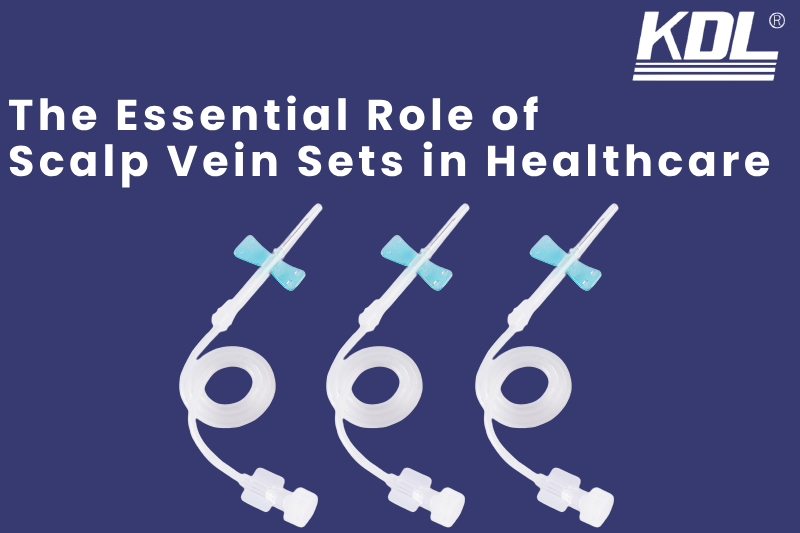
In the world of healthcare, where precision and patient comfort are paramount, a seemingly humble yet indispensable tool takes center stage the scalp vein set. These unassuming devices have quietly revolutioniz the way intravenous (IV) access is achieve and maintained in various medical settings. In this comprehensive blog post, we will delve into the essential role played by scalp vein sets in modern healthcare.
What is Scalp Vein Sets?
Scalp vein sets, also known as scalp vein needle, are medical devices use to access veins on the scalp for various purposes, such as drawing blood, administering medications, or providing intravenous (IV) fluids, particularly in infants and young children. These sets consist of a thin, flexible catheter or needle attached to a plastic hub or connector. The hub often has wings for easy handling and secure placement.
Scalp vein set are design to be smaller and less invasive than traditional IV catheters, making them suitable for use in the delicate and small veins found on the scalp of pediatric patients. They are typically insert into a superficial vein on the scalp, secured in place with tape or adhesive, and connected to tubing for the administration of fluids or to collect blood samples.
How are Scalp Vein Sets Use?
Here’s a general overview of how scalp vein set are typically use
Patient Assessment
Before using a scalp van set, healthcare professionals assess the patient to determine if accessing the scalp veins is appropriate. This assessment includes evaluating the patient’s age, medical condition, and the availability of suitable scalp veins.
Gathering Supplies
Healthcare providers gather the necessary supplies, which may include the scalp vein set, sterile gloves, antiseptic solution, adhesive tape, IV fluids or medication, and a syringe or IV bag if needed.
Hand Hygiene and Sterile Technique
Healthcare professionals wash their hands thoroughly and maintain sterile technique throughout the procedure to minimize the risk of infection.
Preparing the Patient
The patient is typically position comfortably, with their head support to expose the scalp area where the vein access is require.
Vein Selection
Healthcare providers identify an appropriate vein on the scalp, often choosing a superficial and easily accessible vein. Vein selection is critical to minimize discomfort and potential complications.
Cleaning the Site
The selected site on the scalp is clean using an antiseptic solution to reduce the risk of infection.
Needle Insertion
The needle or catheter from the scalp vein set is gently insert into the selected scalp vein. The wings on the hub of the set are use to stabilize the needle or catheter.
Securing the Device
Once the needle or catheter is in place, it is secured using adhesive tape or a dressing to prevent movement or dislodgments.
Connecting Tubing
If necessary, flexible tubing is connected to the hub of the scalp vein set. The other end of the tubing can be attached to an IV bag, syringe, or other medical equipment for the administration of fluids, medications, or blood collection.
Monitoring and Care
Healthcare providers closely monitor the patient to ensure that the scalp vein access is functioning correctly and that there are no signs of complications, such as infiltration or infection.
Removal and Disposal
When the scalp vein access is no longer need, the healthcare provider carefully removes the scalp vein set, ensuring that the needle or catheter is properly disposed of in a sharps container. The insertion site is inspect for any signs of bleeding or infection.
It’s important to note that the use of scalp vein sets should be performed by trained healthcare professionals to minimize the risk of complications. Proper care and maintenance of the scalp vein access site are essential to prevent complications such as infection or tissue damage.
Advantages of Scalp Vein Sets
Access to Small Veins
Scalp vein set are designed for accessing small and delicate veins, making them suitable for infants, young children, or patients. With fragile veins, where traditional intravenous catheters may be too large or invasive.
Minimized Discomfort
The small size of scalp vein sets reduces the discomfort experienced by patients during insertion compared to larger.
Improved Precision
Healthcare professionals can achieve more precise and accurate venipuncture with scalp vein sets, especially when targeting veins in challenging areas, such as the scalp, where precision is crucial.
Reduced Risk of Infiltration
Infiltration occurs when fluids intended for the bloodstream enter the surrounding tissues. Scalp vein sets are less likely to cause infiltration due to their small gauge.
Less Risk of Phlebitis
Phlebitis is the inflammation of a vein, often caused by the irritation of the vein wall by the catheter. The smaller size and gentle insertion of scalp vein sets reduce the likelihood of phlebitis.
Ideal for Short-Term Use
Scalp vein sets are commonly use for short-term IV therapy, such as administering medications, fluids, or blood products.
Greater Mobility
The small and flexible nature of scalp vein sets allows patients to have greater mobility and freedom of movement while receiving treatment. This is particularly important for pediatric patients who may be restless.
Reduced Scarring
Scalp vein sets leave smaller puncture wounds compared to larger catheters, resulting in less scarring and improved cosmetic outcomes.
Easier Removal
Removing scalp vein sets is generally easier and less painful than removing larger catheters, which can be a benefit to both patients and healthcare providers.
Versatility
Scalp vein set come in various sizes and configurations, making them adaptable to a wide range of clinical scenarios and patient needs.
Conclusion
scalp vein set are valuable medical devices use for accessing veins on the scalp, particularly in neonatal and pediatric patients. They offer a range of benefits, including minimized discomfort, reduced tissue trauma, versatility, and improved patient comfort.
However, it’s crucial to emphasize that the use of scalp vein set should be follow out, by professionals following proper procedures and techniques. The choice to use scalp vein set should be based on the patient’s age, condition, and specific clinical needs.
 +86-791-8686-1216
+86-791-8686-1216 

